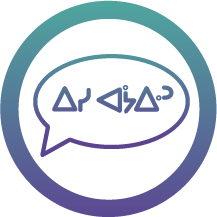Were you able to access care and resources in your preferred language?
Context
More than 70 different languages are spoken within First Nations, Inuit or Métis communities across Canada with Cree, Inuktitut, Ojibwe, Oji-Cree and Michif having the highest number of fluent speakers1.
Over sixty per cent (60%) of Inuit seniors 65 and older report Inuit languages as their mother tongue and similarly, a high percentage (35%) of First Nations seniors converse in their mother tongue.
For Inuit, the Official Languages Act of Nunavut2 recognizes Inuktut (Inuktitut and Inuinnaqtun) as official languages within the territory. In the Northwest Territories there are 11 Indigenous languages in everyday use. For Métis, Michif is the language preferred by many Elders.
Some patients, especially older adults who are seeking care and treatment, may feel more comfortable speaking their first language and may require translation.
Why is this indicator important to First Nations, Inuit and Métis?
First Nations, Inuit and Métis communities face barriers to care due to having a non-official (English or French) first language.3
People who have language barriers may receive poor quality care and may be at greater risk for medical errors, unnecessary tests and adverse reactions to treatment.3
The use of First Nations, Inuit and Métis languages in a medical care setting can create a more welcoming environment for patients, improve the patient’s sense of comfort and cultural safety and encourage them to return for follow up care.
How does this affect care and outcomes?
Understanding cancer diagnosis and treatment and navigating the cancer care system is extremely challenging if English or French is not a patient’s first language.
Language barriers can have a negative impact on access to care, patient consent and confidentiality, their understanding and ability to follow their treatment plans and quality of care4.
Misunderstanding and miscommunication can pose a risk to patient safety as it can lead to misdiagnoses and medical errors such as medication being improperly prescribed4.
In addition to language barriers, ensuring that medical terminology is communicated in plain language is key.
Apart from patient safety, culturally safe care is also an important aspect of high-quality care.
First Nations, Inuit and Métis languages and culture are inseparable. Together they influence beliefs about health and wellness, health-seeking behaviours, how one tends to one’s health and to patterns of communication.
Understanding and respecting these diverse world views is a cornerstone of culturally competent care.
Towards health equity
Health equity is attained when everyone has a fair and just opportunity to reach their full health potential. Reducing barriers and avoidable differences in care is part of this.
Efforts to address language barriers and provide culturally safe care can have a positive impact on access to health care, quality of care, rights of patients, patient and provider satisfaction, and most importantly, on patient health outcomes.
What this would mean for people in Canada
Universal health care is a deeply held value in Canada; however, not all are able to access and benefit from this when language barriers are present.
Outcomes will improve when First Nations, Inuit and Métis patients who speak their ancestral language are able to access and receive high quality and safe care in the language of their choice.
- The Aboriginal languages of First Nations people, Metis and Inuit, 2017 https://www12.statcan.gc.ca/census-recensement/2016/as-sa/98-200-x/2016022/98-200-x2016022-eng.cfm
- Office of the Language Commissioners of Nunavut, Annual Report 2015-2106 https://langcom.nu.ca/sites/langcom.nu.ca/files/OLCN%20AnnualReport_15-16_REV05.pdf
- Bowens, S., 2001, “Language barriers in access to health care” https://www.canada.ca/en/health-canada/services/health-care-system/reports-publications/health-care-accessibility/language-barriers.html
- 2015, Office of the Language Commissioner of Nunavutit, “If you cannot communicate with your patient, your patient is not safe” https://langcom.nu.ca/sites/langcom.nu.ca/files/QGH%20-%20Final%20Report%20EN.pdf

